Question
Anyone ever experience a small explosion from an electric motor? I went to turn on my 5hp bandsaw and there was a wicked flash and a boom like a 12 gauge. The bandsaw was still running. I was on the feed side, thankfully. So I did not actually see flames blowing out the end of the motor. And from what I can tell the end is sealed. I am even unsure if it could have been electrical, whether power cord arcing or dust collection releasing static electricity.
The 4" flex hose, SJO power cord, and a trailer receiver all lay amongst each other on the concrete floor. This was a mean blast. I'm sure everyone in the neighborhood heard it. Like I said, the bandsaw never stopped running. I powered down the whole shop at the panel, not wanting to even touch the saw at that moment.
I looked all over for signs of electrical grounding out. The power cord was all in fine repair. I opened the capacitor block and there seemed no explosion from there, though it should have blown the box all to *%#@.
Power to the bandsaw was good, so I powered up and everything sounded fine. Started good. Made a cut but felt uneasy, so I pulled the plug.
Could there have been an arc between the ungrounded DC hose and the bandsaw insulated power cord? Static electricity igniting dust that settled on the hose? Wish I had a better view of what happened when it did. Any thoughts where to start?
Forum Responses
(Solid Wood Machining Forum)
From contributor J:
You say this has capacitors? Leading me to think it is single phase. Can you confirm this? If so, there are usually two capacitors (not always). When you removed the covers, did it have a bad odor? I can't describe it. It's just real pungent.
In a 1~ motor there is a switch that is attached to the arbor that opens/closes at a given RPM. This is the click you hear on some motors when you start and stop them - the switch is opening and closing. This switch engages a capacitor. Which capacitor is determined on the type of motor. Generally there are 3 types of capacitors. Start, Run, Start/Run.
Let's assume you have a simple two capacity motor. When the motor is at rest, the start capacitor will be activated when power is applied to the motor. This capacitor sets up a false lag in the electrical phase and causes the motor to rotate. Without this lag, the motor does not know to rotate clockwise or counter-clockwise. Once the motor reaches a given rpm the click you hear is a centrifugal switch changing states.
Sometimes the run capacitor is on full time; sometimes it is called for via the centrifugal switch. The run capacitor adds an extra boost of power to the motor when placed under load. It is possible to damage the run capacitor and not the start capacitor. You will notice that the motor will perform like it is weak when placed under heavy load. This is a very brief description of what happens in a 1~ motor.
To your other question, Yes. Static can jump from a dust collection hose to ground. If it passed into your power cord I would be very surprised. If this happened, most likely it would be to something metal that is grounded. Regardless, you should have all your dust collection grounded, whether it is metal or plastic. Wood dust will explode, not just burn. Have you ever noticed dust particles clinging to the dust hose?
On the grounded DC, yeah I know…
Has anyone seen a flash of electricity grounding itself out from a hose to a metal part on the floor? Could the trailer hitch on the floor be considered a ground?
Like I said, there were no telltale signs of what occurred. No black spots, not soot, cindered parts, etc. The bandsaw was a Minimax MM16, about 6 years old with moderate heavy use. Don't know if the European motors are different in design than American.
So, the DC is certainly a strong possibility, but I would still lean towards something in the motor. But I am a technician - I look at stuff with that prejudice.
Your understanding of the American/European motors is correct. For what we are discussing here, there is little difference. Principles and basic concepts are the same or very close.
So Minimax is down for the weekend. The machine still turns on. The local winding shop said they could test/replace capacitors. Thoughts on how to proceed?
I would like to think the capacitors could be removed, then taken for a bench test at the local electrical shop. I have heard they can store juice and I should be wary about handling them.
I'd hate to have to remove the whole motor. Why would a capacitor fail? Should I be looking for a cause other than part failure? Any thoughts to cost?
After opening the cover, place a multimeter across the capacitor terminals. Is there any voltage? If there is, you should see it dissipating the longer you keep the meter attached. It should dissipate quickly.
Finally, short the two terminals with a screwdriver. This will neutralize the capacitor. Then remove them. It should not be necessary to remove the motor unless it restricts the access. If both test as functional, it could be the centrifugal switch. It is usually found underneath the fan, but sometimes it is inside of the motor housing.
The motor seems fully enclosed with a fan attached to the end of the motor shaft protruding through the end cap. The fan then has the metal housing to protect. The cap box is mounted on the side of the motor and easy access.
I'd love to hear what MM has to say... I had ordered parts for an F1 and it took all of seven months to get it online again. Don't think they will cover it anyway.
I have a bit of electrical experience. Mostly wiring residential circuits, can do panels, and have wired two shops and a couple three phase converters. But I had great support. I am no engineer. So, is it possible to figure out from these pics how to drain the juice from the caps so I could get them to the rewind shop on Monday? Or I could probably find electrical parts online too. What are the causes of cap failure?
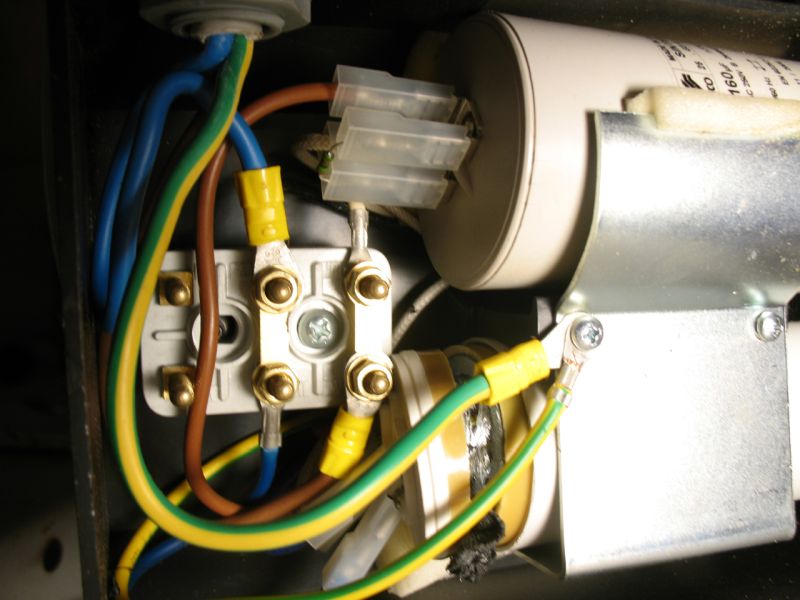
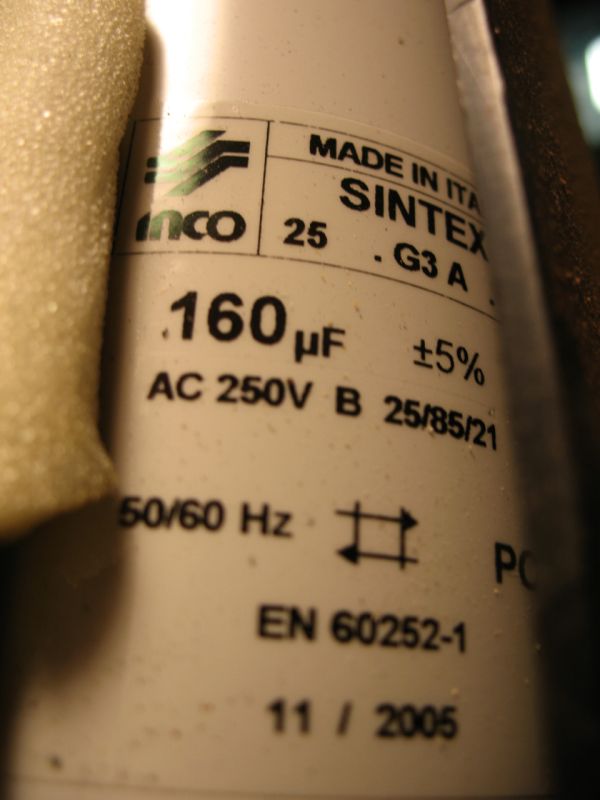
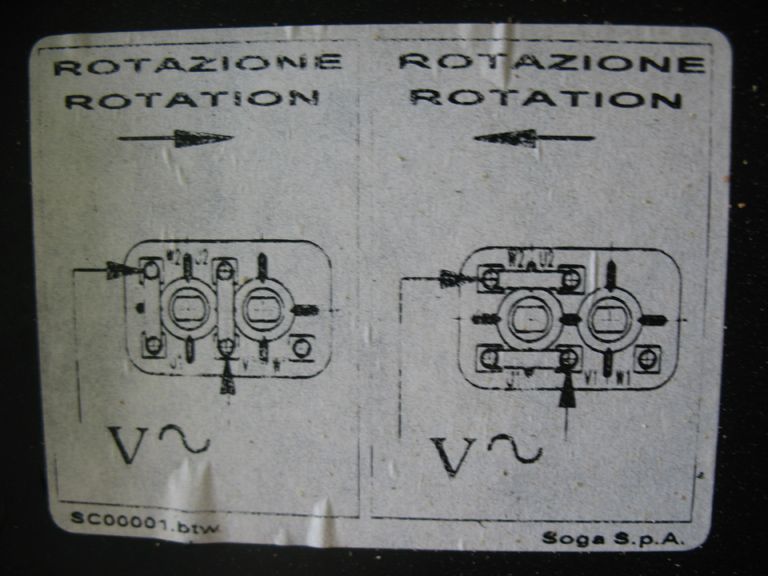
Curious… The one cap that shows the windings - does it look like it blew its guts out? Wasn't sure why it looked that way when I first saw it. Definitely the odd ball out.
Additionally, there is no need to remove both. Just replace the one that has obviously exploded.
I am unsure if I need an exact replacement - one from Italy sold as the Inco Syntex brand - or brand X with matching specs, i.e. 250v 160uf 50/60 hz. I guess I will discharge via 120v lamp.
Interesting as the contacts are labeled prev. and prst. Previous and present? This is to get the motor going in the right direction? This must be a start cap right? I labeled them of course. Hopefully the replacement will have obvious marks for reconnecting.
Thanks for all that have helped thus far. Still unsure of a good avenue for replacement. Cost, etc. I know local winding shops will be list price or more. Anyone think it matters if I get an Italian make to replace?
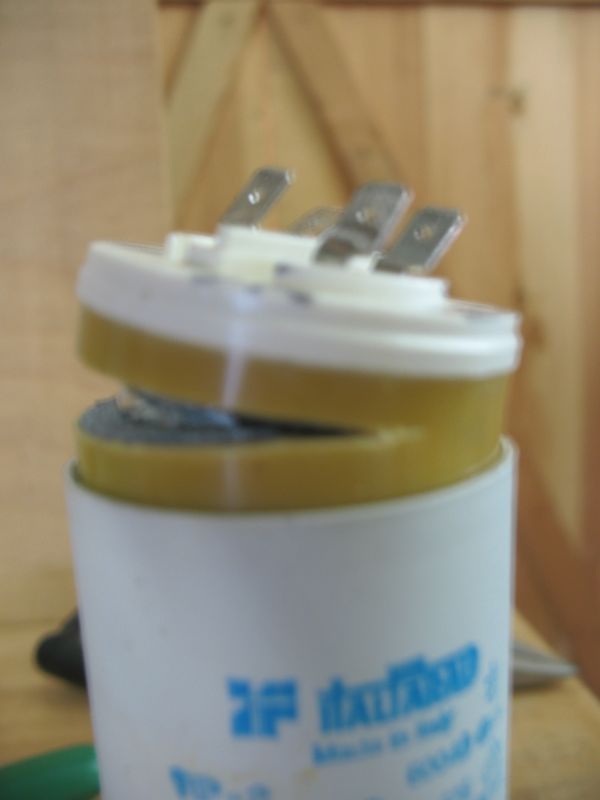

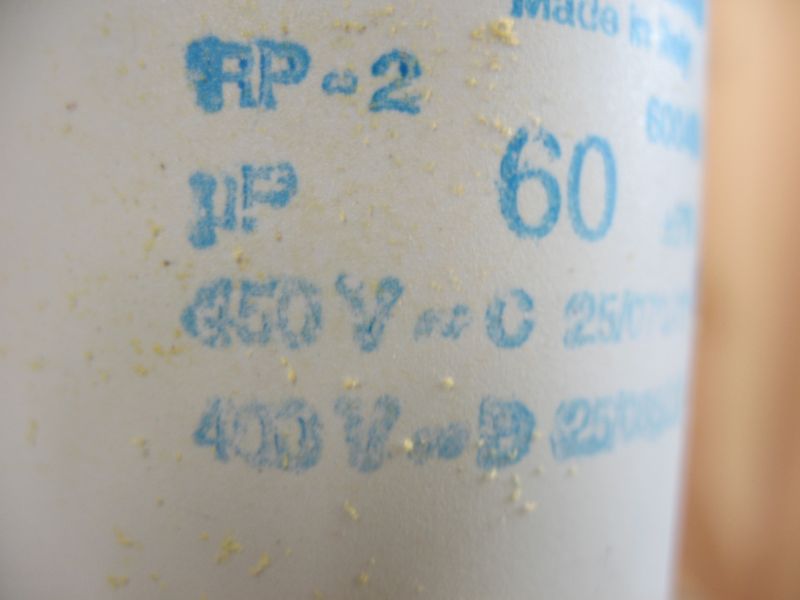
Another factor to consider if getting an aftermarket replacement is the temperature rating, which is only a factor if you are mounting it in the original enclosure (not a Frankenstein mount in some other location where it can have air circulation).
Incidentally, you should be able to pick up an equivalent at a local motor shop, so there is probably no need to spend much time on a web search.
I would like to thank everyone that leant a hand in me swapping out my first blown cap. I think the fear of god slowed me down a little, but no harm in being overcautious. Still skittish running the machine. It scared the sh*t out of me when it blew up. Good to keep you on your toes.
In any case, shorting the terminals of a capacitor with a screwdriver is a very good way to get hurt. A capacitor is capable of discharging all of its stored energy in an instant when shorted. Even a modest size capacitor can create an arc strong enough to send a glob of molten metal into your eye.
I personally enjoyed the concept of the light build method lacking any more appropriate means to do so. I would be most concerned if I was discharging with a screwdriver and the damn thing blew up like it did when this one exploded. I still wince when I turn on the machine. Does anyone use "explosion proof" caps? Seems they would be a logical choice.
But, and it is a big but, your caution is legitimate, and thanks for voicing your concerns. Just because I do it, and it has never had any negative consequence, doesn't hold true for everyone. Electricity is funny that way.
For example: While it may be fairly safe to short a 20uF 120V cap, somebody who does not know the difference and reads the advice may end up shorting a cap charged to 600V with a capacity of 1200 or 1300 uF or larger. (Lighting ballast for example.)
I am a long time electronics hobbyist, tinker with the high voltage hobby (Tesla coils, spark gaps, etc.), and have many years of experience with single and three phase motors and drives ranging from fractional horsepower to those well over 1000HP.
As a teenager, I got whacked pretty hard (blown out of the back of the set) by a capacitor in a console TV flyback circuit. I was attempting to short it with a screwdriver. I have also blown up a few large oil filled caps in similar fashion and seen some downright scary arc flash accidents.
While a start cap on a 240VAC motor may not have the same ability to jump or create an arc flash large enough to blind or burn you, it is still best to avoid shorting it. In favor of a lengthy explanation of Ohm's law that will glaze over the eyes of those not interested and only looking for advice, it is often easier to give the safest advice possible that will allow them to get the job done.
Somebody mentioned reading the same advice in many other forums. That is what concerns me - advice often gets passed along by those who don't really understand the ramifications or context of the advice but take it at face value. That means (again at least in my opinion) that those truly in the know need to be careful how they convey advice regarding potentially dangerous subjects.
Just a small addition to the thread: When replacing the cap or considering how to discharge it, note that this is a cap designed for AC applications to produce a phase shift (to cause the motor to start in the correct direction and rotate as previously mentioned), rather than a cap designed for DC applications. They are very different animals. Capacitors in DC applications can retain a charge after the power is removed (unless discharged by a bleeder resistor), and should be carefully discharged prior to handling as they can be lethal. A fully charged HV capacitor can retain a charge for days and provide very large amounts of energy when accidentally discharged.
On the other hand, while it's certainly possible, an AC capacitor in a motor start/run application doesn't typically retain a charge after the power is removed (or the capacitor explodes), so there's less risk. That said, experienced technicians typically place a screwdriver across the terminals of any capacitor as a final precaution before handling. I'd certainly agree that a more gentle discharge such as a light bulb or resistor is preferable (and less exciting), but the screwdriver is ultimately the final test (no risk of a blown light bulb not discharging the cap).